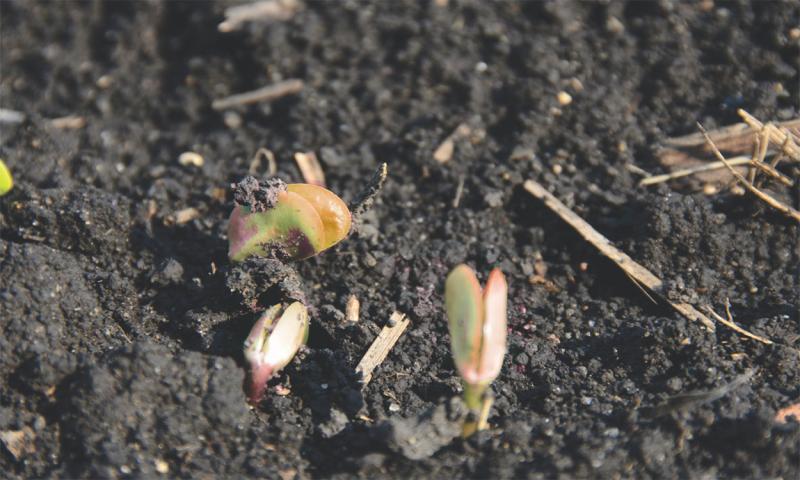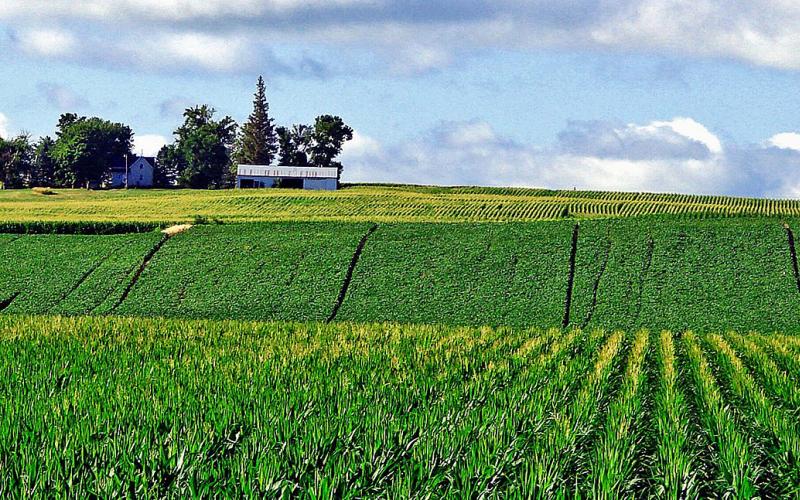
Originally Published: May 5, 2023
Written with contributions by Jonathan Kleinjan, former SDSU Extension Agronomist.
Cool springs can lead to planting delays and concerns regarding row crop emergence. Corn and soybeans are particularly susceptible to low-temperature stress during germination, emergence, and seedling stages. The inherent risks associated with low soil temperature environments include chilling injury, cold stress, delayed or uneven emergence, and greater seed exposure to soil-borne diseases and insects.
Corn and Soybeans
Corn and soybeans are sensitive to cold and wet soils during the imbibition period, which occurs as soon as the seed is exposed to moisture (usually immediately after planting). If the first water that enters into the seed to rehydrate cells (imbibition) is below 50 degrees Fahrenheit, cells can rupture, which leads to non-viable, swollen kernels or seeds, and aborted growth of roots and shoots. The risk of injury largely occurs when planting into dry, cool soils immediately followed by a cold weather precipitation event. Corn seeded into wet soils with soil temperatures above the 50 degrees Fahrenheit threshold for the first 48 hours after planting should germinate just fine. Soybeans have a shorter imbibition period; a soil temperature above 50 degrees Fahrenheit for 24 hours is generally considered adequate for proper germination.
Small Grains
Small grains, such as wheat and oats, conversely, are considered cool-season crops and are generally more frost-tolerant early in their life cycle. The growing point for most cereal crops (including corn) generally stays below the soil surface for several weeks after emergence, keeping somewhat protected from cold air temperatures. In small grains, the growing point extends above the soil surface just prior to jointing (6-leaf stage). At or after jointing, as long as temperatures do not drop below 25 degrees Fahrenheit for a prolonged period of time, wheat will likely survive a cold snap with minimal injury to plant tissue or growing points.
Other Considerations
Even if proper germination occurs, soil temperatures below the mid-40s for several days can be a cause for concern for emerging crops. Emergence may take 20 days or longer, depending on growing degree days (abbreviated as GDDs) accumulated after planting. It is possible to check the growing conditions for at any weather station in South Dakota with the GDD tool at the SDSU Mesonet website. Remember that many soil-borne pathogens can substantially affect both corn and soybean emergence due to cold, wet soils, with root and seedling rots being a major factor. These conditions may compound plant health issues if factors, such as soil crusting, ponding, compaction, or potential herbicide injury, also exist. Most commercial seed treatments contain fungicides to help protect against such pathogens, and producers can check with seed dealers on options to consider.
Assessing Injury
So, how do you tell if there is injury to your crop? Be patient. No one likes to hear, “Let’s wait and see,” but it is imperative to do so. With current cold temperatures, corn and soybean development can be significantly slowed from what many perceive as the “norm” this time of year, so patience in checking seedling development is vital.
When scouting for injury and stand establishment, be sure to check different parts of fields and remember that good yields are still possible even with reduced stands. There are several extension publications available online discussing corn, soybean, and wheat stand evaluations.
References
- Specht, J., J. Rees, P. Grassini, N. Mueller. 2015. Chilling Injury in Corn and Soybeans. CropWatch. University of Nebraska Extension. Lincoln, NE.
- Nielsen, RL (Bob). 2019. Emergence Failure of Corn. Corny News Network, Purdue Univ. Extension.

